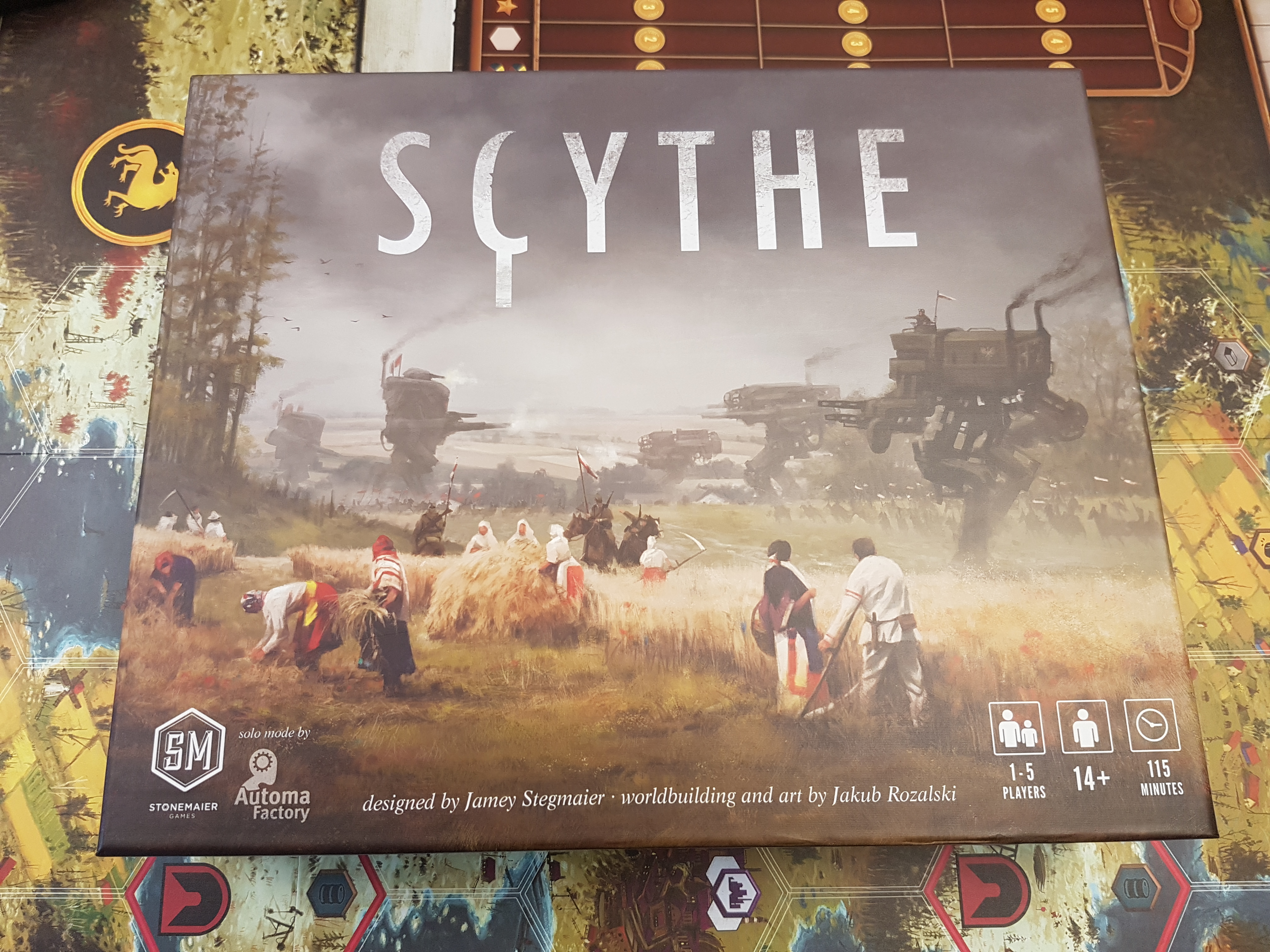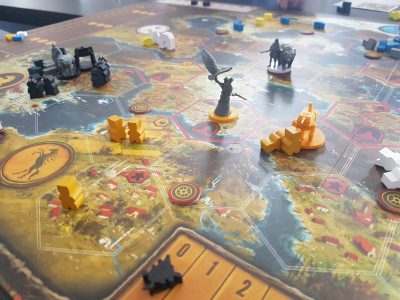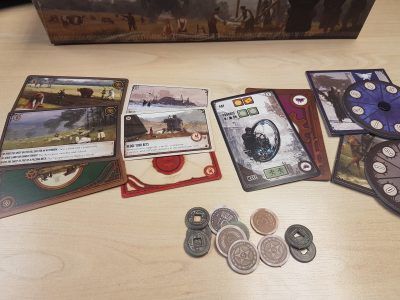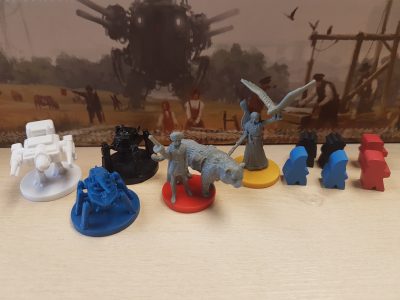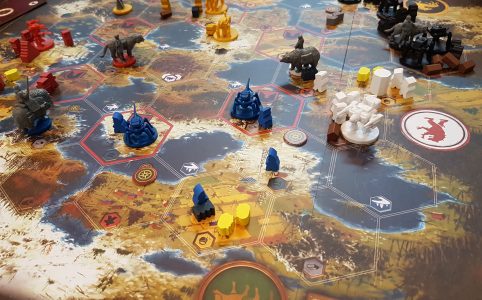Faction based mech and player character abilities come in several forms but each faction has two similar abilities. All factions have Speed which gives +1 movement to mechs and characters. By default players cannot move units across rivers. Thankfully, given the number of rivers on the board, each faction has an ability to cross rivers to select terrain types. For example, Polania can only cross rivers onto villages or mountains hexagons and Crimean Khanate can only cross onto farm or tundra. Each base faction has these 2 abilities, with slight variation coming from the river crossing.
The remaining two abilities are faction specific, though some are similar. Polania and Nordic Kingdoms are the only factions to have an ability to utilize lake hexagons, via Submerge and Seaworthy respectively. Each faction has at least one combat focused abilities that help weaken the enemy but these range from paying 1 Power to reduce an opponent’s Power by 2 to Rusviet’s ability of playing additional combat cards for having workers in the hexagon. These unique combinations and abilities means playing each faction has access to a unique strategy, whether players use that is up to them. No railroading is forced upon players; the choice is up to them.
The game board and even the lore of the Scythe revolves around a huge city-state that developed many mechs, known simple as The Factory. This hex has relevance from the start of the game, right through to the end. If you get your player character to the factory you get to take one of the factory cards. When you get one of these cards, pick up all cards remaining in the pile, after having a look through choice one and return the others. This enabled players to effectively have a 5th option of actions with a different Top and Bottom row actions. Players can only gain one Factory card so why is the tile still important? Not only can players actively block others obtaining a Factory Card by defending the hex, controlling the tile at the conclusion of the game counts as three territories not just one. It adds yet another decision for players to make, should you venture early in the game to The Factory for the option of choosing the best card or build up slowly in other areas.
Other cards players will interact with are Encounter cards and Objective cards. Encounters occur when player characters enter territories with encounter tokens on. These offer that player three options, which by default they can only do one of. The common theme is the first two options involve helping in some way, simply gaining something or paying coins to gain some resource or even build a building. The third option is always the most sinister and brutal option that involves screwing over the local populous. This includes but is not limited to steering wild boars into a helpless village or practising shooting at unsuspecting, overly enthusiastic, soldiers. Naturally these still gain the player something but come at the expense of popularity. Whomever chooses these options is clearly heartless… but is it all fair in love and war?
Objective cards are, as the name suggests, objectives that players can complete to score a star. By default players only gain a star for 1 objective but each player receives two giving some wiggle room for fitting one or another objective into their strategy. These vary from having equal numbers of workers and recruits to having a combat victory star and 8 combat cards in your hand. By receiving two the game feels like it balances itself, as an objective a player deems hardest can just being ignored. I wouldn’t suggest building a master plan instantly around either objective instead part way into the game determine which you’re closer to and zero in on it. Otherwise you risk having tunnel vision for that objective and falling behind in other areas.
Scythe is unashamed of its perceived heavy nature. The game comes in a big heavy box and it is quite reminiscent of the game inside, that fills the box completely. Scythe is a real thinker of a game with planning and strategy often coming to the forefront: making the game incredibly similar to turn based strategy video games. Games will be big, epic and long but if you know that going in then there is a great experience to be had. As with the very best strategy games player decision is constantly the driving factor behind the direction of the game, whether that is you or your opponents’ actions.
Learning to adapt plans is what can bag you coins at the end of the game or reduce the amounts gained by others. Sometimes moving workers into hex you know an opponent wants to march a mech into, while displacing your worker, will reduce another players popularity. Thus, reducing their end game coin multiplier for stars, territory and resources. It is a constant trade-off of when to sacrifice workers, territory, resources and commodities of all kinds that builds the risk/reward strategic side of Scythe. This forms plenty of different strategies. Strategies that players will want to learn and plan even after the very first playthrough.
Beautiful. One word that simply describes the visual part of the Scythe experience. When a game’s illustrations are actively sort out by many for canvases and prints you know the game will look good. What I didn’t expect was that every piece of unique artwork is nothing short of epic. The only, and I mean only, issue with the art is that I find myself in awe of it to such an extent that in my first games I was exactly distracted by its brilliance. This isn’t to say after a few games its shin has worn off. More so, the surprise of the quality of art had been replaced with a depressing self-confession I would never be able to produce art of such quality. The love that has been paid to the art flows through the game. Even the wooden worker meeples show the same level of thought and passion, each having different shaped hats depending on the faction they belong to.
I must admit a rather weird sensation rolled over me when reading the Scythe rulebook. A feeling unlike any other I had experienced when reading a rulebook… excitement! What started out as a big and daunting rulebook turned into a well-written fully in-depth explanation of how to play that just made me want to play more and more. I’m mostly impressed with the detailing. No feature is left skimmed over, with examples constantly used throughout to backup the understanding of the rules. You might not be able to take on a Scythe veteran from the get go but you’ll be able to hit the ground at least walking.
Throughout this review I haven’t exactly held back and as a result you can probably see the excitement and enjoyment Scythe has created spilled onto the page. I’m taken aback at how well designed the game is from the very mechanics, to the 31 page rulebook which carefully steps players through everything. From the stunning artwork to the use of plastic and wooden player pieces to make a distinct different between combat and non-combat units/buildings. Everything of Scythe has been well thought-out. The game combines many simple rules yet it doesn’t result in a confusing complex mess instead everything presents decisions and potential strategies for players. Jamey Stegmaier is known to be a top game designer and he has certainly hit the sweet spot with Scythe. Scythe is the sort of game that makes you forget how long you’ve been playing for. One that’ll make you think where a game was won or lost so next time you’ll come out victorious. That feeling that it creates, making the game stick in your mind, is why Scythe will get to the table time and time again.
[Editor’s Note: Scythe was provided to us for review purposes by Esdevium Games. The game is currently available from 365 Games for £52.99]

